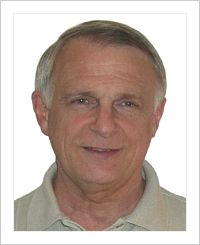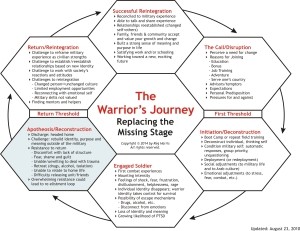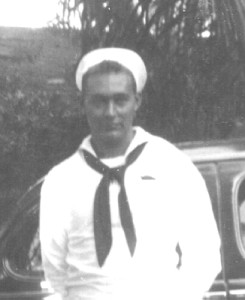NOTE: You are welcome to link to this article, but do not copy or repost it..
“This Might be of Help”
by Reg Harris
I first encountered the Hero’s Journey in 1975 when I was hired by St. Helena High School (St. Helena, CA) to replace a teacher who had to leave just one month into the school year. When I walked into her classroom on my first day, I found a paper on her desk with a note attached. “This might be of help,” the note said. Around the edge of the paper was a basic outline of the hero’s journey, with the center of the page open for student writing. I didn’t realize it at the time, but that paper would eventually determine the direction of my life.
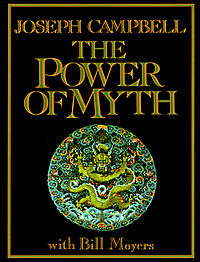 For the next six years at St. Helena, I used the hero’s journey to teach mythology and fantasy. Not until 1985, however, a decade later, did I begin to appreciate the depth and importance of the journey archetype, and I began using it not just for myth and fantasy, but for literature and film in general. Then, in 1988, after watching the PBS documentary The Power of Myth, with Bill Moyers and Joseph Campbell, I started serious research into the pattern. I began by studying Joseph Campbell’s work, reading virtually everything he wrote.
For the next six years at St. Helena, I used the hero’s journey to teach mythology and fantasy. Not until 1985, however, a decade later, did I begin to appreciate the depth and importance of the journey archetype, and I began using it not just for myth and fantasy, but for literature and film in general. Then, in 1988, after watching the PBS documentary The Power of Myth, with Bill Moyers and Joseph Campbell, I started serious research into the pattern. I began by studying Joseph Campbell’s work, reading virtually everything he wrote.
Campbell’s model of the hero’s journey intrigued me for two reasons. First, I was struck by its universality, that it appeared—at least in its basic form—in cultures throughout the world and throughout time. Second, I marveled that this particular pattern resonated so deeply with all peoples in all times. I began to see the importance of myth and story in our lives, both as repositories for cultural knowledge and values and, in personal myths, as guiding stories in our own lives.
My Journey Moves into Psychology
I continued to incorporate the hero’s journey in my secondary language arts classes, developing new ways of using the pattern not just to help students better understand literature and film, but to help them use the journey as a link between the stories they read and the lives they lived: a bridge between literature and life. I discovered that students could use the journey archetype as a guide to apply the themes and lessons from literature to their own experience so that they could better understand themselves and the challenges they face in their own journeys.
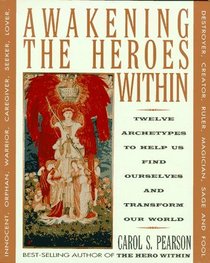 By the late 1990s, when I was at Vintage High School (Napa, CA), I had become interested in the psychology of the Hero’s Journey. I moved away from Campbell and into the transformative dynamics of the journey process itself—into the mechanism of human growth and transformation. Because Campbell had frequently referred to Jung, I began by studying Jungian psychology, particularly Jung’s theory of archetypes. I also explored Gestalt therapy and Buddhist psychology, along with reading work by psychologists who had adapted elements of the journey to understanding everyday life. These included Carol Pearson, Sam Keen, Jean Houston, and Paul Rebillot. During this time I also expanded my reading of hero mythology, looking particularly for connections between myth and the psychology of human experience.
By the late 1990s, when I was at Vintage High School (Napa, CA), I had become interested in the psychology of the Hero’s Journey. I moved away from Campbell and into the transformative dynamics of the journey process itself—into the mechanism of human growth and transformation. Because Campbell had frequently referred to Jung, I began by studying Jungian psychology, particularly Jung’s theory of archetypes. I also explored Gestalt therapy and Buddhist psychology, along with reading work by psychologists who had adapted elements of the journey to understanding everyday life. These included Carol Pearson, Sam Keen, Jean Houston, and Paul Rebillot. During this time I also expanded my reading of hero mythology, looking particularly for connections between myth and the psychology of human experience.
A Guide to Literature and Life
In 1995 I teamed with Susan Thompson, another teacher at Vintage High School, to do a presentation on the hero’s journey for state convention of the California Association of Teachers of English. The tremendous interest we found at that convention motivated us to do more conferences and then to write and publish the award-winning teaching guide The Hero’s Journey: A Guide to Literature and Life. (The guide is now being used by schools in 42 states and 17 countries.)
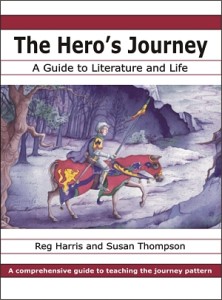 Susan left Vintage shortly after we finished the book, but I continued to work independently on my hero’s journey research. In 2001, I began a master’s degree program in psychology at Sonoma State University specifically for that purpose. My post-graduate work focused on the psychological, developmental, and transformational processes represented in the hero’s journey pattern. At Sonoma, my studies expanded to include narrative therapy, humanistic and existential psychology, phenomenology and hermeneutics (the science of interpretion).
Susan left Vintage shortly after we finished the book, but I continued to work independently on my hero’s journey research. In 2001, I began a master’s degree program in psychology at Sonoma State University specifically for that purpose. My post-graduate work focused on the psychological, developmental, and transformational processes represented in the hero’s journey pattern. At Sonoma, my studies expanded to include narrative therapy, humanistic and existential psychology, phenomenology and hermeneutics (the science of interpretion).
My studies in hermeneutics and narrative therapy produced some profound insights into the hero’s journey process and the role of narrative in our lives. I developed a deep appreciation for the power that myth and story have to shape our self perception, to guide our interactions with the world and to help us heal and grow. My 153-page MA thesis, The eternal circle: A hermeneutic model of the heroic journey archetype, presented an original, psychological model of the journey process. That model is grounded in narrative therapy, hermeneutics and existential psychology, and it is the basic model I use in my publications and my work.
From Theory to Practice
In the years since my work at Sonoma, I have gone from studying the psychological dynamics of the hero’s journey pattern to applying my theories to real-life situations outside of education. From August 2010 to April 2011, I worked with a team of psychologists, psychiatrists and neurobiologists at the University of California, San Francisco, to build an on-line class to help veterans returning from Iraq and Afghanistan make the difficult readjustment to civilian life. The program combined the hero’s journey with neurobiology and narrative therapy.
My work has found other therapeutic uses, as well. I helped a psychologist friend develop a six-month group therapy program called “Personal Transformation” that is helping prisoners overcome life-long problems and become more mature and productive individuals. The Hero’s Journey: A Guide to Literature and Life is also being used in counseling and intervention programs in the U.S. and Australia.
Over the years, I have presented dozens of workshops and seminars on the Hero’s Journey and related topics, ranging from in-service workshops for individual schools to presentations at state conventions for the California Association of Teachers of English and the Oregon Council of Teachers of English. In June of 2007, I was a featured speaker at the 30th Anniversary Tribute to Star Wars at Modesto Junior College. My presentation, “Use the Force, George,” explored the influence of Joseph Campbell on George Lucas and the expression of the heroic journey pattern in Star Wars IV: A New Hope, the original 1977 film.
My Three Passions
Even though I am retired from teaching, I am still fascinated by the hero’s journey and its power to influence our lives. Several years ago, I developed a keen interest in neurobiology, especially the work of Michael Gazanniga. According to Gazzaniga (2011), we have an neurological mechanism in our brain that organizes our lives as narratives. This mechanism, which he calls the “interpreter,” works constantly to give context, order and meaning to the chaos of experience. “This is what our brain does all day long,” Gazzaniga tells us. “It takes input from other areas of our brain and from the environment and synthesizes it into a story.” This narrative mechanism, I believe, could be the source of the hero’s journey or narrative archetype, which would explain why it resonates with all peoples in all cultures in all times.
Since my work at the University of California, San Francisco, I have developed a passion to apply the power of the hero’s journey to helping combat veterans make a full return to their civilian lives. My father was a veteran of World War II and was at Pearl Harbor when it was bombed. He suffered the effects of the war throughout his life, and I would like to help today’s veterans avoid the difficulties my father faced. I believe that we can do that by using the journey as a framework for therapy. With the journey as a guide, we can help veterans complete their “Warrior’s Journey” with a successful return home.
Finally, my years of teaching, especially at-risk students, has shown me that the Hero’s Journey can be both a powerful tool for intervention and a means to help teens negotiate the turbulent waters of adolescence. With the journey as both a map and a mentor, they can find a broad perspective from which to view their current challenges within the context of their whole lives. This perspective, I believe, will help them grow from their experiences so that they can build rich and fulfilling lives.
Now, at age 69, this is my final goal with the hero’s journey: to help others who are growing or struggling to use the journey to negotiate and benefit from the challenges they face in their lives.
